Happiness is a Warm CNC Machine Tool
North Korea has, in recent years, been making a big fuss about its access to Computer Numerical Control (CNC) machining capabilities. And, when the North Koreans make a fuss, that’s really saying something. The DPRK propaganda apparatus has devoted an enormous amount of attention to the topic of CNC machine tools, right down to postage stamps, oil paintings and patriotic songs.
What sort of place sings about CNC machine tool—even if such tools do make nice missiles and zippy centrifuges? The song is not the strangest thing the North Koreans have done, by the way, to celebrate their machine tools. That distinction goes to the decision to award the title of “labor hero of the DPRK” to a lathe. (The DPRK has been known to award state titles to tanks, fighter planes and other equipment, as well as to art troupes, military units, factories, corporations and dead people.)
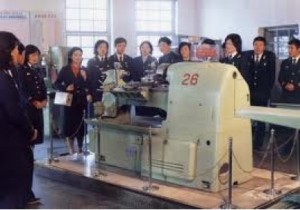
The decorated lathe is purportedly a historic artifact. Kim Jong Il personally manned it as a student, sayeth KCNA, presumably before hitting the links for a round of golf. Making a labor hero out of a lathe is a part of a broad campaign that includes the surreal variety-show number: postage stamps and a float in the most recent military parade. State media is emphasizing the modernization of the DPRK’s industrial capabilities as part of a general effort to present the Kim family as competent, modernizing rulers.
One should not be surprised, then, that visits to factories either making or using CNC machine tools are a steady element of regime propaganda and an opportunity for the senior leadership to crack heads. For those of us interested in North Korea’s nuclear programs, these visits are particularly interesting. The diffusion of CNC machine tools over the past few decades is the fundamental technological driver that helped A.Q. Khan develop his own centrifuge program that fueled nuclear programs in Pakistan, Libya, Iran and, oh yes, the DPRK.
So, when Kim Jong Un stands in front of a fancy flow-forming machine, believe you me, my colleagues and I take notice. MIT’s Dr. Scott Kemp, writing at Arms Control Wonk.com—a blog I publish—wrote an entry entitled “Is This Where North Korea Makes Its Centrifuges?” Scott explained how the equipment would appear to support the view that North Korea either has, or is rapidly acquiring, the basic industrial base to support its program to use gas centrifuges to enrich uranium. Whether or not the objects on display are in fact involved in the manufacture of centrifuges is impossible to say. But I take Scott’s point to be that these capabilities suggest North Korea is less dependent on foreign sources of support for its uranium enrichment program than it has been in the past.
North Korea’s Centrifuge Program
After North Korea threw out IAEA inspectors in April 2010, they immediately began refurbishing one of the fuel fabrication buildings. When Sig Hecker last visited the building, it look like this. When he returned in November 2010, he was stunned to see thousands of what certainly appeared to be centrifuges based on a Pakistani design called the P-2. (North Korea has now doubled the size of this facility, based on images analyzed by our friends at the Institute of Science and International Security.)
The United States had been aware of North Korea’s interest in centrifuge technology since the late 1990s, although the gradual unfolding of the Khan network around 2002 was causing a reassessment of the scale of such a program. When the US determined that North Korea had imported enough aluminum tubes for 4,000 centrifuges, US intelligence analysts were shocked at the scale of the effort. They became concerned that North Korea was constructing a large centrifuge facility but did not know where.
In October 2002, the United States confronted North Korea over its enrichment efforts, a confrontation that eventually led to the collapse of the Clinton-era Agreed Framework. A prolonged period of the tension followed, resulting in a replacement framework within the Six Party process. When that process fully collapsed with the expulsion of IAEA inspectors in April 2009, North Korea began building the enrichment plant at Yongbyon.
The revelation to Hecker in 2010 raised a series of unanswered questions: Were the centrifuges real or just for show? If they are real, does North Korea manufacture any of the components? Where does North Korea do this? And is facility at Yongbyon the first and only facility in North Korea? And we still don’t know enough about the program to answer a number of important policy questions. Is the program producing HEU? What effect, if any, are sanctions and export controls having? If North Korea were to agree to freeze or end the production of highly enriched uranium, could we verify it?
Huichon Machine Plant
Kanggye is not the first site that has been identified as a possible home for either North Korea’s production of centrifuge components or a covert enrichment facility. In May 2009, the late Kim Jong Il visited the Huichon General Machine-Tool Plant. Rodong Sinmun, the official daily newspaper of the Workers’ Party of Korea, carried a very interesting image of a CNC machine tool with some metal tubes on a table. Do aluminum tubes ring a bell?
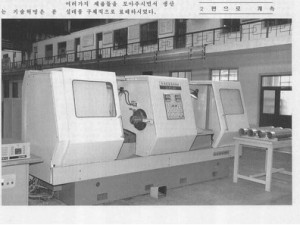
North Korean TV also displayed a series of photos of Kim Jong Il standing next to the enigmatic tubes. Kim is also surrounded by top officials from the Munitions Industry Department, including Pak To Chun, Ju Kyu Chang, and our old friend Jon Pyong Ho. The story was recounted briefly in Jonathan Pollack’s excellent2011 bookNo Exit. Experts immediately began asking whether these tubes were for North Korean centrifuges.

The tubes—as can best be inferred from these images—don’t seem to match the centrifuges that Pakistan’s A.Q. Khan provided to North Korea. The ratio of the diameter to the length is not consistent with the dimensions of aluminum tubes previously acquired by the DPRK to manufacture outer casings for its gas centrifuges—they are too long.[1] The dimensions are a closer fit for the rotor that sits inside the casing, but there are other inconsistencies. (In the images with Kim Jong Il, the tubes appear to have end caps, which raises the question of whether they might be solid objects. But going by the picture showing the opposite ends, they are hollow.) For comparison with outer casings supplied by the Khan network, here is George W. Bush in 2004 standing next to casings manufactured by the A.Q. Khan network in Malaysia that were obtained from Libya.
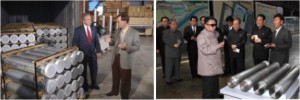
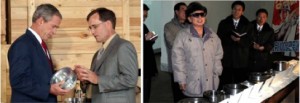
Ultimately, the photographs are probably not sufficient to determine the purposes of the aluminum tubes and other components. In the case of Iraq, the IAEA was able to demonstrate that the aluminum tubes were simply too thick for an Iraqi centrifuge program.[2] We just don’t have that sort of data here.
Based on photographs released by the DPRK as well as the maps behind Kim Jong Un, the Huichon General Machine Tool Plant is located at 40°11’16.55″N, 126°13’51.58″E. (I have posted a longer discussion of how to match the images of Kim to buildings at Huichon at ArmsControlWonk.com.) The identification also helps demonstrate that North Korea renamed the Huichon General Machine Tool Plant as the “Huichon Ryonha General Machinery Plant” (or sometimes just the Ryonha General Machinery Plant”) sometime between May and December 2010.[3]
The DPRK manufactures machine tools for export under the multiple variants of the “Ryonha” brand name. The UN Panel of Experts details a number of these different names in its most recent report. Based on available open source evidence, this appears to be the major production facility for CNC tools in North Korea.[4] If the machine tools on display in Kanggye were made in North Korea, chances are they were made in Huichon.
In 2011, the Chosun Ilbo quoted an unidentified defector who claimed that North Korea builds its centrifuges at a facility near Huichon. The defector also seemed to imply that the North would operate a centrifuge facility there to take advantage of the electricity generated by the Huichon Dam. This site is relatively close to Yongbyon where North Korea constructed its first declared centrifuge facility. Huichon is also home to other industrial sites, including the Huichon Precision Machine Factory and the Huichon Youth Electric Complex, which might supply components to a centrifuge facility
Kanggye Tractor Factory
In May 2013, Kim Jong Un visited the Kanggye General Tractor Plant. Like the Huichon General Machine Plant, Kim Jong Il and Kim Jong Un have made a number of visits to this site.
Indeed, Kim Jong Il appeared at the site in 2009 with yet another set of enigmatic metal tubes. The dimensions of these tubes appear closer to P-2 casings obtained in Libya, although it is difficult to determine the thickness of the tubes. (They may also be preforms that will be machined into a casing with thinner walls.) It is tempting to wonder if Kim Jong Il was simply delighted to be standing next to any metal tubes given the tendency of Western intelligence agencies to fixate on them.
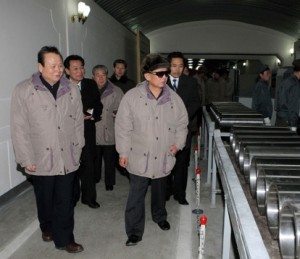
Whatever their purpose, it is very unlikely the tubes are tractor parts—indeed it is unlikely that North Korea produces any tractors at this facility. Tractor production does not require high-end flow-forming machines, as Kemp points out, although one can use them to make high performance wheel rims. (If you’d like to see how a CNC flow-forming machine turns a tube into a wheel rim, see here and here.)
Rather, the Kanggye General Tractor Plant, also known as the “No. 26 Factory,” has been identified by defectors as a facility that produces munitions including ballistic missiles, artillery shells and torpedoes. (North Korea has another major facility near Pyongyang that may handle final assembly of the missiles.)
The primary open source information about Kanggye comes from a defector, Ko Chong Song, who was an employee of the factory in various capacities from the 1980s until his defection in 1994. Ko provided a very accurate physical description of the facility, including the location of various control points. He wrote a book in Japanese, as well as provided interviews with Sankei Shimbun and author Bradley Martin. Other defectors have identified the general area as a site of a large munitions plant linked to the North Korean missile program. Once again, the exact location can be determined using images of Kim Jong Un’s visit and satellite imagery. The main entrance to the Kanggye General Tractor Plant is located at: 40°57’39.34″N, 126°36’21.76″. (A longer discussion is posted at ArmsControlWonk.com.)
This is certainly a plausible location for the manufacture of some or all DPRK centrifuge components. The facility is set against a hillside, where defectors indicate North Korea has sited the main production lines. There are a number of buildings that appear to serve as entrances for the tunnels in which Kim Jong Il is standing. The rooms appear to be tunnels. The factory floor is narrow, has no natural light and a curved roof with piping running overhead. Moreover, there are no above-ground buildings at the site, with the lone exception of the new sports center, that has curved roofs. As Scott noted, the sports center is one of several amenities that mark the location as being important.
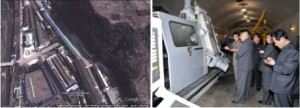
It is not possible, however, to determine whether the underground facility produces components for missiles, centrifuges, conventional munitions or something else. The machines themselves are not indicators, unless you can see details such as the dimensions of the mandrels to determine the size and shape of what the tools are making. (The mandrel holds the tube in place while the tool shapes it.) Even then, as is the case that Iraq demonstrates, we ought to be cautious in interpreting technical details or drawing conclusions from broad similarities.
Moreover, we simply can’t judge the quality of the machine tools. Some defectors have reported that the quality of the machine tools remains low. Some of the tools are marked with the Ryonha brand, suggesting they were made in North Korea. Others, however, still carry manufacturers’ marks from in Taiwan. The North Koreans, as late as 2009, were still attempting to acquire high-end machine tools from abroad. (Something we know from the recent indictment of two Taiwanese-Americans.) One can look at this as either evidence of continued dependence or a sample of the large-scale procurement effort that supported the program to equip Kanggye and a dozen other factories with modern CNC machine tools.
Conclusion
The debate over North Korea’s CNC machine tools is less about the locations involved in North Korea’s centrifuge program and more about the prospects for sanctions and other forms of pressure to slow North Korea’s nuclear weapons programs. The Huichon Ryonha General Machine Tool Plant and Kanggye General Tractor Factory are not the only places in North Korea that produce or use CNC machine tools. (In June, Kim Jong Un visited another CNC equipped factory just a few miles from the Kanggye Tractor Factory, one suspected of making small arms ammunition.) But the Huichon Ryonha General Machine Tool Plant and Kanggye General Tractor Factory are high profile sites linked to military production that help inform our debate about North Korea’s level of technical achievement. Oh, and then there are those tubes.
One view is that sanctions and export controls offer a viable route to constrain North Korea’s illicit WMD programs. The efficacy of such measures is probably a political precondition for sustaining international support for sanctions on the DPRK. As the UN panel of experts noted, “while the imposition of sanctions has not halted the development of nuclear and ballistic missile programs, it has in all likelihood considerably delayed the timetable of the Democratic People’s Republic of Korea.”
Now, I don’t know what “considerably delayed” means in this context, but it is worth asking whether any sanctions-induced delay is about to run out given the images we’ve seen at Huichon and Kanggye. It is perfectly plausible to believe that sanctions have been effective in buying time, while also worrying that we’ve squandered that time.
The North Korean party line, obviously, is that they are now completely self-sufficient in everything. The tenets of Juche and Songun demand no less. The state propaganda apparatus is busy pointing out that North Korea, under the watchful leadership of the Kim family, is building a strong, modern economy despite sanctions and other foreign predations. (Sorry, I should have warned you in case you had a mouthful of coffee that just came out of your nose.)
Still, one doesn’t have to be a pin-wearing member of the Chosen Soren to look at North Korea’s machine tools and wonder whether the horse is well and truly out of the barn. Scott certainly thinks so. “Even if this ‘tractor factory’ is not where P-2 rotors are fabricated,” Scott argued, “it would still be remarkable for showing that North Korea possesses many of the key technologies needed.” Even if sanctions have been effective, Scott suggests that this may not be the case much longer because “it appears that North Korea is, at a minimum, well on its way to freeing the centrifuge program from dependence on foreign supplies and technology.”
Ultimately, eliminating North Korea’s nuclear and missile programs requires a diplomatic resolution of outstanding issues relating to regional security and human rights. Whether or not North Korea is self-sufficient in the production of machine tools or not doesn’t really change that, although it is an important detail that would help us understand how quickly North Korea can expand its illicit weapons programs and shape provisions for the monitoring and verification of any agreement.
So, we are left staring at photographs released for propaganda and marketing purposes.
Well, there is another possibility. Ryonha does publish these fancy brochures and attends trade fairs, all to talk up the possibility of exporting North Korean machine tools. If we really wanted to know how well these machine tools work, we could just buy some. The United States set up a “red team” centrifuge facility using components acquired from Libya. At least one press report suggests this site is someplace in Europe, presumably to be closer to the expertise and manufacturing capabilities of the URENCO countries—the United Kingdom, Netherlands and Germany. (In case anyone at WINPAC—the CIA Weapons Intelligence, Nonproliferation, and Arms Control Center—is reading this: I’d love a tour.) The US intelligence community could, in theory, purchase a number of Ryonha machines to see if they are capable of making the components for P-2 centrifuges that the Khan network sold to Libya, Iran and North Korea. This is, in principle, a question we can answer.
The only issue is cost. A high-end flow-forming machine can easily cost in the tens of thousands of dollars, even if the North Koreans will take payment in sugar or some other form of barter. In the era of sequestration, the intelligence community might find it hard to spend more money on their P-2 sandbox. So, in the spirit of the US State Department’s arms control innovation challenge, maybe we should start a kick-starter campaign to buy WINPAC a North Korean flow-forming machine.
Just a suggestion, really.
Jeffrey Lewis is Director of the East Asia Nonproliferation Program at the James Martin Center for Nonproliferation Studies, Monterey Institute of International Studies. Amber Lee is a graduate research assistant at the James Martin Center for Nonproliferation Studies, Monterey Institute of International Studies.
[1] The tubes acquired in Germany were approximately 20 cm by 110 cm. David Albright reports the Russian tubes were the “same dimensions” as the German tubes. North Korea subsequently melted down the tubes and allowed the United States to take environmental samples. The smelted metal was contaminated with highly enriched uranium.
[2] See: David Albright, “The CIA’s Aluminum Tubes’ Assessment: Is the Nuclear Case Going Down the Tubes?” ISIS, March 10, 2003; and David Albright, “Iraq’s Aluminum Tubes: Separating Fact from Fiction,” ISIS, December 5, 2003.
[3] We know the references to the “Ryonha General Machinery Plant” refer to the main facility in Huichon because the workers from this plant enjoyed a holiday in Pyongyang, after which they returned to Huichon City. See: “Those from Ryonha General Machinery Plant Leave Pyongyang,” KCNA, November 9, 2011, http://www.kcna.co.jp/item/2011/201111/news09/20111109-42ee.html.
[4] There are rumors of another Ryonha site near Pyongyang, probably in Mangungdae-gu, Pyongyang. A longer discussion of this issue is available at ArmsControlWonk.com.
